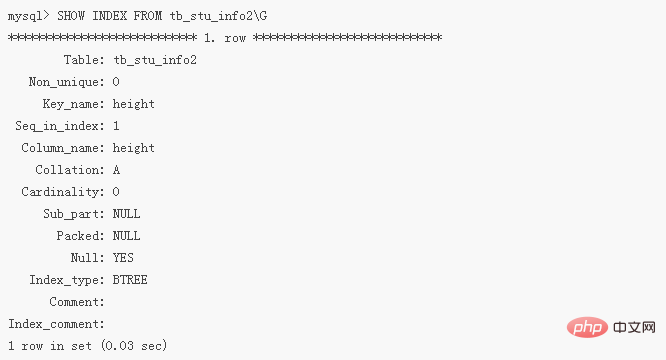How to modify the index type in mysql
Mysql method to modify the index type: 1. Use the "DROP INDEX index name ON table name;" statement to delete the original specified index; 2. Use "CREATE index type keyword INDEX index name ON table name (column Name [length])" statement creates an index with the same name to modify the type.

The operating environment of this tutorial: windows7 system, mysql8 version, Dell G3 computer.
There is no direct instruction to modify the index in MySQL. Generally, we need to delete the original index first, and then create an index with the same name as needed, so as to modify the index in disguise.
mysql Modify index type
#1. Delete the original index
When the index is no longer needed , you can use the DROP INDEX statement to delete the index.
Grammar format:
DROP INDEX <索引名> ON <表名>
The syntax description is as follows:
: The name of the index to be deleted. : Specify the table name where the index is located.
Example:
tb_stu_info2 Index information of the data table

It can be seen from the output results : "Key_name: height"--The name of the index is "height", "Index_type: BTREE"-The type used by the index is "BTREE"
Delete the index height in the table tb_stu_info2
DROP INDEX height ON tb_stu_info2;
Copy after login2. Create an index with the same name
You can use the CREATE INDEX statement specifically used to create an index to create an index on an existing table, but this statement cannot create a primary key.
Syntax format:
CREATE <索引名> INDEX ON <表名> (<列名> [<长度>] [ ASC | DESC])
Copy after loginThe syntax description is as follows:
: Specify the index name. A table can create multiple indexes, but each index has a unique name in the table. : Specify the name of the table to create an index.
: Specify the column name to create an index. You can usually consider using columns that frequently appear in the JOIN clause and WHERE clause in the query statement as index columns. : Optional. Specifies that the length characters preceding the column are used to create the index. Creating an index using part of a column can help reduce the size of the index file and save the space occupied by the index columns. In some cases, only the prefix of a column can be indexed. The length of an index column has a maximum limit of 255 bytes (1000 bytes for MyISAM and InnoDB tables). If the length of an index column exceeds this limit, it can only be indexed using the column's prefix. In addition, columns of type BLOB or TEXT must also use prefix indexes. ASC|DESC: Optional. ASC specifies that the index is sorted in ascending order, DESC specifies that the index is sorted in descending order, and the default is ASC.
Example:
Create a normal index
CREATE INDEX height ON tb_stu_info2 (height(8));
Copy after loginWhen creating a unique index, the UNIQUE keyword is usually used.
CREATE UNIQUE INDEX height ON tb_stu_info2 (height(8));
Copy after loginExpand knowledge:
The index types in MySQL are as follows
General Index
Unique index
Primary key index
Combined index
Full text index
[Related recommendations: mysql video tutorial]
The above is the detailed content of How to modify the index type in mysql. For more information, please follow other related articles on the PHP Chinese website!
Statement of this WebsiteThe content of this article is voluntarily contributed by netizens, and the copyright belongs to the original author. This site does not assume corresponding legal responsibility. If you find any content suspected of plagiarism or infringement, please contact admin@php.cn
Hot AI Tools

Undresser.AI Undress
AI-powered app for creating realistic nude photos

AI Clothes Remover
Online AI tool for removing clothes from photos.

Undress AI Tool
Undress images for free

Clothoff.io
AI clothes remover

Video Face Swap
Swap faces in any video effortlessly with our completely free AI face swap tool!

Hot Article
Assassin's Creed Shadows: Seashell Riddle Solution3 weeks ago By DDDWhat's New in Windows 11 KB5054979 & How to Fix Update Issues2 weeks ago By DDDWhere to find the Crane Control Keycard in Atomfall3 weeks ago By DDDAssassin's Creed Shadows - How To Find The Blacksmith And Unlock Weapon And Armour Customisation1 months ago By DDDRoblox: Dead Rails - How To Complete Every Challenge3 weeks ago By DDD
Hot Tools

Notepad++7.3.1
Easy-to-use and free code editor

SublimeText3 Chinese version
Chinese version, very easy to use

Zend Studio 13.0.1
Powerful PHP integrated development environment

Dreamweaver CS6
Visual web development tools

SublimeText3 Mac version
God-level code editing software (SublimeText3)

Hot Topics
CakePHP Tutorial 1387
1387
 52
See all articles
52
See all articles How to open phpmyadmin
Apr 10, 2025 pm 10:51 PM
How to open phpmyadmin
Apr 10, 2025 pm 10:51 PM
You can open phpMyAdmin through the following steps: 1. Log in to the website control panel; 2. Find and click the phpMyAdmin icon; 3. Enter MySQL credentials; 4. Click "Login".
 MySQL: An Introduction to the World's Most Popular Database
Apr 12, 2025 am 12:18 AM
MySQL: An Introduction to the World's Most Popular Database
Apr 12, 2025 am 12:18 AM
MySQL is an open source relational database management system, mainly used to store and retrieve data quickly and reliably. Its working principle includes client requests, query resolution, execution of queries and return results. Examples of usage include creating tables, inserting and querying data, and advanced features such as JOIN operations. Common errors involve SQL syntax, data types, and permissions, and optimization suggestions include the use of indexes, optimized queries, and partitioning of tables.
 How to use single threaded redis
Apr 10, 2025 pm 07:12 PM
How to use single threaded redis
Apr 10, 2025 pm 07:12 PM
Redis uses a single threaded architecture to provide high performance, simplicity, and consistency. It utilizes I/O multiplexing, event loops, non-blocking I/O, and shared memory to improve concurrency, but with limitations of concurrency limitations, single point of failure, and unsuitable for write-intensive workloads.
 MySQL's Place: Databases and Programming
Apr 13, 2025 am 12:18 AM
MySQL's Place: Databases and Programming
Apr 13, 2025 am 12:18 AM
MySQL's position in databases and programming is very important. It is an open source relational database management system that is widely used in various application scenarios. 1) MySQL provides efficient data storage, organization and retrieval functions, supporting Web, mobile and enterprise-level systems. 2) It uses a client-server architecture, supports multiple storage engines and index optimization. 3) Basic usages include creating tables and inserting data, and advanced usages involve multi-table JOINs and complex queries. 4) Frequently asked questions such as SQL syntax errors and performance issues can be debugged through the EXPLAIN command and slow query log. 5) Performance optimization methods include rational use of indexes, optimized query and use of caches. Best practices include using transactions and PreparedStatemen
 Why Use MySQL? Benefits and Advantages
Apr 12, 2025 am 12:17 AM
Why Use MySQL? Benefits and Advantages
Apr 12, 2025 am 12:17 AM
MySQL is chosen for its performance, reliability, ease of use, and community support. 1.MySQL provides efficient data storage and retrieval functions, supporting multiple data types and advanced query operations. 2. Adopt client-server architecture and multiple storage engines to support transaction and query optimization. 3. Easy to use, supports a variety of operating systems and programming languages. 4. Have strong community support and provide rich resources and solutions.
 Monitor Redis Droplet with Redis Exporter Service
Apr 10, 2025 pm 01:36 PM
Monitor Redis Droplet with Redis Exporter Service
Apr 10, 2025 pm 01:36 PM
Effective monitoring of Redis databases is critical to maintaining optimal performance, identifying potential bottlenecks, and ensuring overall system reliability. Redis Exporter Service is a powerful utility designed to monitor Redis databases using Prometheus. This tutorial will guide you through the complete setup and configuration of Redis Exporter Service, ensuring you seamlessly build monitoring solutions. By studying this tutorial, you will achieve fully operational monitoring settings
 How to view sql database error
Apr 10, 2025 pm 12:09 PM
How to view sql database error
Apr 10, 2025 pm 12:09 PM
The methods for viewing SQL database errors are: 1. View error messages directly; 2. Use SHOW ERRORS and SHOW WARNINGS commands; 3. Access the error log; 4. Use error codes to find the cause of the error; 5. Check the database connection and query syntax; 6. Use debugging tools.
 How to connect to the database of apache
Apr 13, 2025 pm 01:03 PM
How to connect to the database of apache
Apr 13, 2025 pm 01:03 PM
Apache connects to a database requires the following steps: Install the database driver. Configure the web.xml file to create a connection pool. Create a JDBC data source and specify the connection settings. Use the JDBC API to access the database from Java code, including getting connections, creating statements, binding parameters, executing queries or updates, and processing results.























